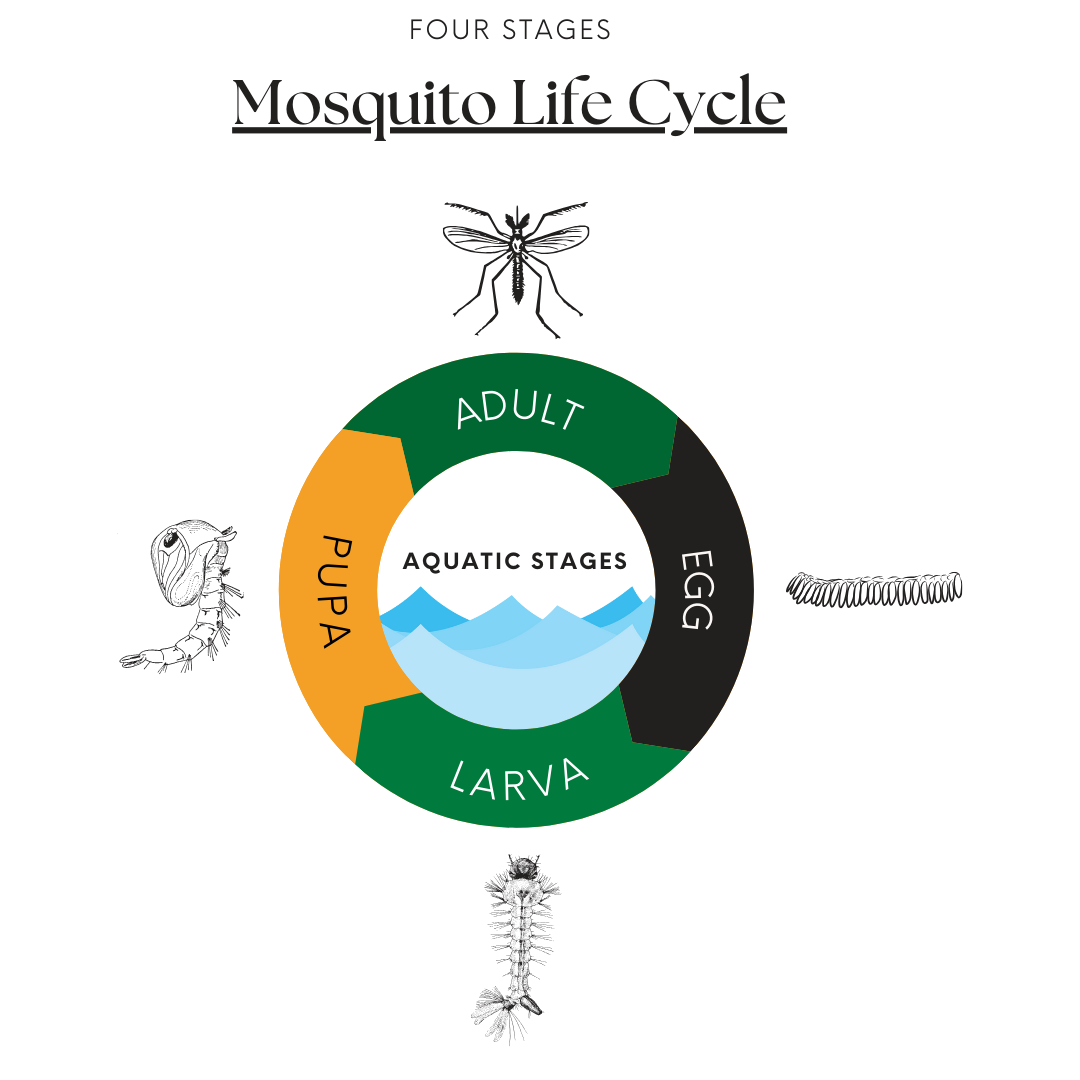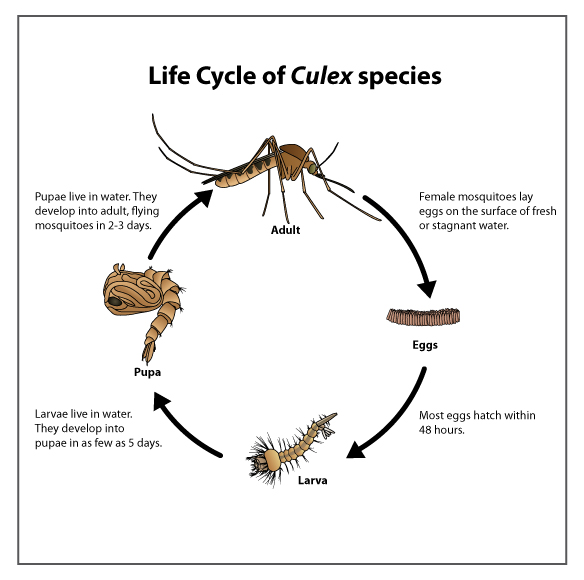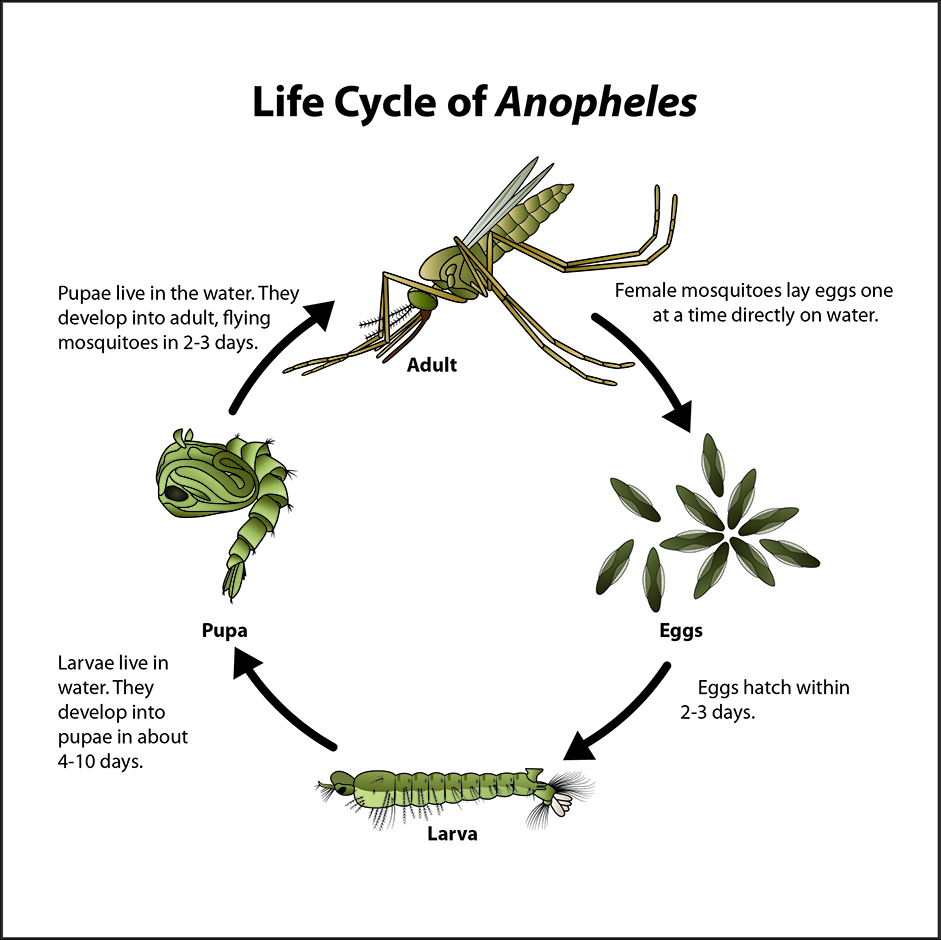Mosquito Life Cycle
Click on the different stages of the mosquito life cycle below to learn more about how mosquitoes develop from an egg to an adult.

Egg & Egg Raft Stage
Egg & Egg Raft Stage
Larva Stage
Mosquito larvae live and develop in stagnant water. They are adapted to all aquatic habitats except for open water, such as lakes and the sea, as well as fast-flowing streams. During development, larva will feed on algae, bacteria, yeast, fungi, and protozoans found in the water. Most species of mosquito larva breathe using siphons, located near their tails, vertical to the water surface. Some larvae species will breathe horizontal to the water surface, while others can puncture the stems of aquatic vegetation with their siphons to obtain oxygen.
The larva development stage actually involves four steps: 1st through 4th instar stages. These four instar stages allow the larvae to increase their size prior to pupation. This process is typically completed in four to ten days under ideal conditions, such as warm water temperature.
Larva Stage
Mosquito larvae live and develop in stagnant water. They are adapted to all aquatic habitats except for open water, such as lakes and the sea, as well as fast-flowing streams. During development, larva will feed on algae, bacteria, yeast, fungi, and protozoans found in the water. Most species of mosquito larva breathe using siphons, located near their tails, vertical to the water surface. Some larvae species will breathe horizontal to the water surface, while others can puncture the stems of aquatic vegetation with their siphons to obtain oxygen.
The larva development stage actually involves four steps: 1st through 4th instar stages. These four instar stages allow the larvae to increase their size prior to pupation. This process is typically completed in four to ten days under ideal conditions, such as warm water temperature.
Pupa Stage
Pupae often resemble a large comma with a pair of tubes, called “trumpets,” located on the thorax. These allow the pupa to penetrate the surface of the water and breathe. Unlike other insect pupae, mosquito pupae remain relatively active, which is why they are often referred to as “tumblers.” Similar to the larval stage, pupal development takes place entirely in water. However, unlike larvae, pupae will note feed during this developmental stage.
The pupal stage is relatively short, often lasting between two and four days, depending on environmental conditions, similar to those that influence the larval development stage. Once the pupa is ready to emerge as an adult, a split will develop along the back of the pupal case. The newly formed adult mosquito will slowly emerge, resting on the surface of the water. Once the wings of the mosquito are dried and their body parts harden, the adult will take off, seeking food and other mosquitoes to reproduce with.
Pupa Stage
Pupae often resemble a large comma with a pair of tubes, called “trumpets,” located on the thorax. These allow the pupa to penetrate the surface of the water and breathe. Unlike other insect pupae, mosquito pupae remain relatively active, which is why they are often referred to as “tumblers.” Similar to the larval stage, pupal development takes place entirely in water. However, unlike larvae, pupae will note feed during this developmental stage.
The pupal stage is relatively short, often lasting between two and four days, depending on environmental conditions, similar to those that influence the larval development stage. Once the pupa is ready to emerge as an adult, a split will develop along the back of the pupal case. The newly formed adult mosquito will slowly emerge, resting on the surface of the water. Once the wings of the mosquito are dried and their body parts harden, the adult will take off, seeking food and other mosquitoes to reproduce with.
Adult Stage
After approximately two to seven days, adult mosquitoes will emerge from their pupal casing. Adult mosquitoes need to wait on the water surface until their bodies harden and their wings are dry enough to fly. This is why stagnant water is such an important aspect of their breeding habitat.
Adult male mosquitoes commonly emerge first and will linger near the breeding site, waiting for the females to emerge. Due to relatively high adult mortality rates, mating will occur quickly after emergence. Both male and female mosquitoes primarily feed on plant nectar and juices for energy. Unlike females, males do not require a blood meal that is necessary for egg development, and therefore will not feed on other animals
After each blood meal, the female will oviposit her eggs in an appropriate breeding habitat, which vary among species. While some species only oviposit once, some mosquito species lay eggs several times over the course of their lives.
Adult Stage
After approximately two to seven days, adult mosquitoes will emerge from their pupal casing. Adult mosquitoes need to wait on the water surface until their bodies harden and their wings are dry enough to fly. This is why stagnant water is such an important aspect of their breeding habitat.
Adult male mosquitoes commonly emerge first and will linger near the breeding site, waiting for the females to emerge. Due to relatively high adult mortality rates, mating will occur quickly after emergence. Both male and female mosquitoes primarily feed on plant nectar and juices for energy. Unlike females, males do not require a blood meal that is necessary for egg development, and therefore will not feed on other animals
After each blood meal, the female will oviposit her eggs in an appropriate breeding habitat, which vary among species. While some species only oviposit once, some mosquito species lay eggs several times over the course of their lives.
Note: The aquatic stages of the mosquito life cycle include egg/egg raft, larva, and pupa. The adult stage is the only aerial stage of the mosquito life cycle.
Additional Resources
To learn more about the various ways in which different genera of adult female mosquitoes will lay their eggs, please click on the following resources.

CDC | Life Cycle of Mosquitoes that Lay Egg Rafts

CDC | Life Cycle of Mosquitoes that Lay Single Eggs Above Water Level

CDC | Life Cycle of Mosquitoes that Lay Single Eggs On Water Surface